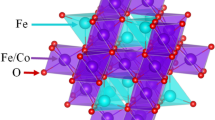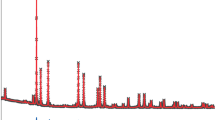Abstract
δ-FeO(OH)-type solid solutions have been synthesized with compositions Fe1−x M x O1−x (OH)1+x ranging up tox=0.10 for M=Ca,x=0.35 for M=Mg or Cd andx=0.40 for M=Zn. The phases are characterized by X-ray diffraction and transmission electron microscope studies. A structural model giving satisfactory intensity agreement is postulated for Fe1−x Zn x O1−x (OH)1+x . In this model, Zn2+ ions are situated in the 0 0 0 octahedral sites of space group D 33d -P¯3ml while the Fe3+ ions are almost equally distributed among both octahedral sites (0 0 0 and 0 0 1/2).
Similar content being viewed by others
References
A. Szytula, A. Burewicz, Z. Dimitrijevic, S. Krasnicki, H. Rzany, J. Todorovic, A. Wanic andW. Wolski,Phys. Stat. Sol. 26 (1968) 429.
J. B. Forsyth, I. G. Hedley andC. E. Johnson,J. Phys. C 1 (1968) 179.
A. Szytula, M. Balanda andZ. Dimitrijevic,Phys. Stat. Sol. (a) 3 (1970) 1033.
A. Oles, A. Szytula andA. Wanic,Ibid 41 (1970) 173.
M. Pernet, J. Chenavas, J. C. Joubert, C. Meyer andY. Gros,Solid State Commun. 13 (1973) 1147.
M. Pernet, J. C. Joubert andC. Berthetcolominas,ibid 17 (1975) 1505.
S. Okamoto,J. Amer. Ceram. Soc. 51 (1968) 594.
M. H. Francombe andH. P. Rooksby,Clay Minerals Bull. 4 (1959) 1.
J. D. Bernal, D. R. Dasgupta andA. L. Mackay,ibid 4 (1959) 15.
S. Okamoto, H. Sekizawa andS. I. Okamoto, “Reactivity of Solids”, Proceedings of the 7th International Symposium on the Reactivity of Solids, Bristol (Chapman and Hall, London, 1972) p. 341.
A. W. Simpson,J. Appl. Phys. 33 Suppl. (1962) 1203.
D. A. Powers, PhD Thesis, California Institute of Technology (1975).
W. Feitknecht,Z. Electrochem. 63 (1959) 34.
S. Okamoto,Kogyo Kagaku Zasshi 67 (1964) 1845.
Idem, ibid 67 (1964) 1850.
Idem, ibid 67 (1964) 1855.
J. -C. Petit,Compt. Rend. 252 (1961) 3255.
S. Okamoto,J. Amer. Ceram. Soc. 51 (1968) 113.
W. Feitknecht andG. Keller,Z. Inorg. Chem. 262 (1950) 61.
N. G. Vannerberg,Ark. Kemi 10 (1956) 455.
I. Dézsi, L. Keszthelyi, D. Kulgawczuk, B. Mcinar andN. A. Eissa,Phys. Stat. Sol. 22 (1967) 617.
C. M. Clark, D. K. Smith andG. G. Johnson, “A Fortran IV Program For Calculating X-Ray Powder Diffraction Patterns-Version 5, Pennsylvania state, University (1973).
H. R. Hoekstra, S. Siegel andF. X. Gallagher,Adv. Chem. Series 98 (1971) 39.
G. Bertrand andY. Dusausoy,Compt. Rend. 270C (1970) 612.
Author information
Authors and Affiliations
Rights and permissions
About this article
Cite this article
Muller, O., Wilson, R. & Krakow, W. δ-FeO(OH) and its solid solutions. J Mater Sci 14, 2929–2936 (1979). https://doi.org/10.1007/BF00611477
Received:
Accepted:
Issue Date:
DOI: https://doi.org/10.1007/BF00611477




